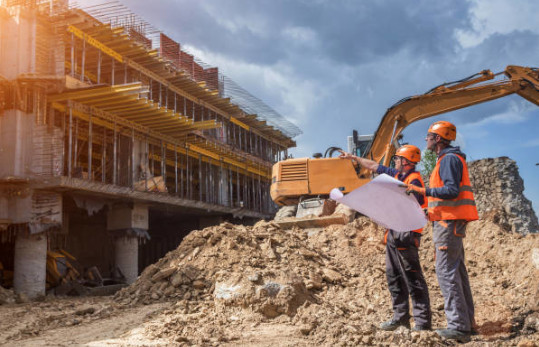Specialized Geotechnical Works for Sustainable Construction Solutions
Specialized Geotechnical Works for Sustainable Construction Solutions
Blog Article
How Consulting Engineers Enhance Geotechnical Design Projects: Insights Into Their Know-how, Methods, and Collaborative Approaches
Consulting engineers are critical in boosting geotechnical design jobs, applying their specialized expertise to browse the complexities of subsurface problems. Their methods include a variety of website examination methods, consisting of Standard Penetration Examinations (SPT) and Cone Penetration Examinations (CPT), which inform essential choices during the style and building stages. Moreover, their collaborative strategies foster communication among varied job stakeholders, inevitably shaping the task's trajectory. As we take a look at the multifaceted roles these experts play, it comes to be clear that their contributions prolong past technological experience, triggering a more detailed look at the ramifications for task success.
Duty of Consulting Engineers
The knowledge of getting in touch with engineers in geotechnical design is basic to the effective implementation of construction jobs. These experts play a pivotal role in evaluating soil and rock properties, which are vital aspects affecting design and construction decisions. By carrying out complete website examinations, seeking advice from engineers accumulate necessary information that notifies the layout process, making certain tasks are developed on steady and appropriate ground.
Consulting engineers also give vital understandings into danger monitoring (geotechnical geologist). They determine prospective geotechnical dangers, such as landslides, soil liquefaction, and settlement issues, enabling stakeholders to implement reliable reduction approaches. Their expertise help in maximizing foundation designs, which can lead to substantial price financial savings and improved safety
Furthermore, getting in touch with designers offer as a crucial web link in between task proprietors, architects, and professionals. Their capacity to convert complicated geotechnical data right into actionable referrals promotes collaboration and facilitates educated decision-making throughout the job lifecycle. This multidisciplinary approach not just enhances task efficiency but likewise ensures conformity with regulatory criteria and best techniques.
Key Methodologies in Geotechnical Design

One main technique is website investigation, which involves carrying out field tests and lab analyses to gather data on subsurface conditions. Methods such as Requirement Infiltration Testing (SPT) and Cone Penetration Testing (CPT) are commonly utilized to review dirt stratigraphy and stamina. Additionally, geophysical methods, including seismic and electrical resistivity surveys, provide non-invasive means to evaluate subsurface features.
Another crucial approach is numerical modeling, which allows engineers to mimic various situations and anticipate exactly how soil-structure interactions will behave under various loading problems. Limited Component Evaluation (FEA) is a typical technique utilized in this context.
Furthermore, the design of structures, retaining structures, and earthworks counts greatly on these methods - geotechnical geologist. By integrating advanced logical devices with area information, seeking advice from engineers can develop customized options that deal with particular task difficulties, eventually adding to the security and safety of construction tasks
Relevance of Soil Analysis
Dirt analysis acts as a foundational aspect in geotechnical engineering, supplying vital understandings into the physical and chemical homes of soil needed for effective building preparation. Comprehending dirt characteristics is important for establishing its load-bearing capability, click here to find out more drainage actions, and possibility for settlement or instability. Detailed dirt investigations, consisting of tasting and lab screening, aid recognize specifications such as dirt kind, moisture material, thickness, and shear toughness.
These evaluations inform the option of suitable building strategies and products, ultimately influencing job safety and security and longevity. For example, natural dirts might require different structure designs compared to granular soils, requiring customized design remedies. In addition, dirt evaluation help in recognizing pollutants that might posture risks to human health or the environment, enabling the development of mitigation methods.
Integrating dirt evaluation right into the onset of job pop over to these guys development helps to minimize unforeseen difficulties, making certain that engineers can expect and resolve prospective concerns prior to they rise. By developing an extensive understanding of the website conditions, getting in touch with engineers can maximize design effectiveness and minimize prices, thus boosting the overall success of geotechnical design jobs.
Collaborative Strategies in Tasks
Effective geotechnical tasks often depend upon collective techniques that combine diverse competence from numerous self-controls. Efficient partnership amongst consulting designers, geologists, ecological researchers, and building specialists is critical for dealing with intricate obstacles and enhancing job outcomes. By leveraging the distinct skills and knowledge of each employee, tasks can profit from a holistic understanding visit this site right here of the website problems, regulatory demands, and engineering restrictions.
Normal communication and interdisciplinary conferences help with the sharing of insights and cultivate a culture of synergy. These collective initiatives make it possible for the identification of prospective threats early in the task lifecycle, enabling prompt mitigation approaches. Additionally, including comments from stakeholders, including neighborhood neighborhoods and regulative firms, guarantees that all viewpoints are considered, improving job acceptance and conformity.
Furthermore, the integration of innovative modern technologies, such as Geographic Details Systems (GIS) and Building Information Modeling (BIM), further improves collaboration. These devices allow for the real-time sharing of data and visualization of geotechnical conditions, promoting informed decision-making. Inevitably, a collective strategy not only improves task implementation however additionally lays the structure for cutting-edge services to intricate geotechnical design challenges.
Effect On Task Results

Consulting engineers employ advanced approaches such as threat assessment and predictive modeling, which boost the precision of project projections. Their capability to incorporate ingenious technologies, like geotechnical instrumentation and information analytics, even more improves the design and construction procedures. Therefore, projects experience boosted efficiency, reduced expenses, and reduced hold-ups.
Furthermore, cultivating efficient interaction and collaboration among employee improves problem-solving abilities. When challenges arise, an unified front permits quick identification of solutions, avoiding possible problems. Inevitably, the collective initiatives of seeking advice from engineers add to better results, making certain that tasks satisfy both regulatory requirements and customer assumptions.
Conclusion

Report this page